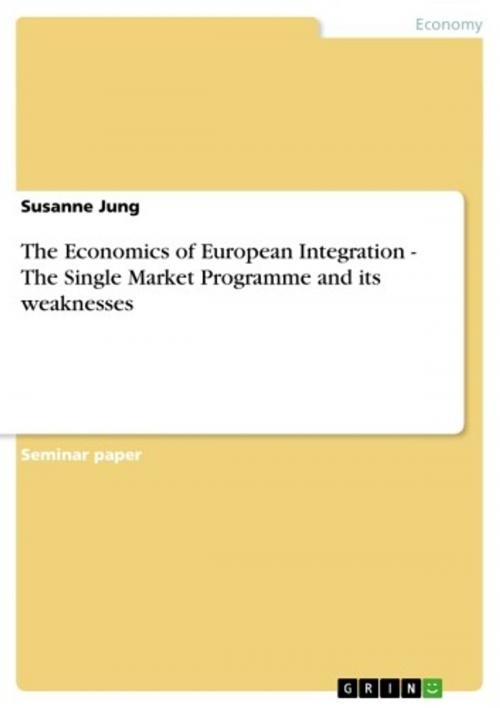The Economics of European Integration - The Single Market Programme and its weaknesses
Business & Finance, Economics, International| Author: | Susanne Jung | ISBN: | 9783638162517 |
| Publisher: | GRIN Publishing | Publication: | January 9, 2003 |
| Imprint: | GRIN Publishing | Language: | English |
| Author: | Susanne Jung |
| ISBN: | 9783638162517 |
| Publisher: | GRIN Publishing |
| Publication: | January 9, 2003 |
| Imprint: | GRIN Publishing |
| Language: | English |
Seminar paper from the year 2002 in the subject Economics - International Economic Relations, grade: 2,0 (B), University of Canterbury (Economics), course: The Economics of European Integration, 11 entries in the bibliography, language: English, abstract: Economic integration can be defined as a long-term process in which several stages improve the level of integration. The first step is a free trade area in which internal visible trade restrictions (customs duties, quotas) between partner counties are removed. Examples for those forms of economic integration are the North American Free Trade Area (NAFTA) and the Asian Free Trade Area (AFTA). Adding a common external tariff for non-member countries to the elimination of internal trade obstacles creates ensuing a Customs Union. The next level of integration, the single market for commodities, is achieved by removing visible and invisible trade barriers. Therefore all restrictions on trade between member-countries are abolished and a common external tariff is imposed on external countries. Following to this level free factor mobility of production and of financial assets generate a common market. Next steps to economic integration are the Monetary and lastly the Economic Union by having a common currency and policy. Theme of this essay is critical arguments of disestablish trade barriers towards the European Union (EU) and its underlying economic theories in respective to the Single Market Programme (SMP), its aims and if they are achieved in terms of labour and social policies. Therefore it is necessary to have a focus on the removal of non-tariff barriers (NTBs) exemplary for goods and labour.
Seminar paper from the year 2002 in the subject Economics - International Economic Relations, grade: 2,0 (B), University of Canterbury (Economics), course: The Economics of European Integration, 11 entries in the bibliography, language: English, abstract: Economic integration can be defined as a long-term process in which several stages improve the level of integration. The first step is a free trade area in which internal visible trade restrictions (customs duties, quotas) between partner counties are removed. Examples for those forms of economic integration are the North American Free Trade Area (NAFTA) and the Asian Free Trade Area (AFTA). Adding a common external tariff for non-member countries to the elimination of internal trade obstacles creates ensuing a Customs Union. The next level of integration, the single market for commodities, is achieved by removing visible and invisible trade barriers. Therefore all restrictions on trade between member-countries are abolished and a common external tariff is imposed on external countries. Following to this level free factor mobility of production and of financial assets generate a common market. Next steps to economic integration are the Monetary and lastly the Economic Union by having a common currency and policy. Theme of this essay is critical arguments of disestablish trade barriers towards the European Union (EU) and its underlying economic theories in respective to the Single Market Programme (SMP), its aims and if they are achieved in terms of labour and social policies. Therefore it is necessary to have a focus on the removal of non-tariff barriers (NTBs) exemplary for goods and labour.















